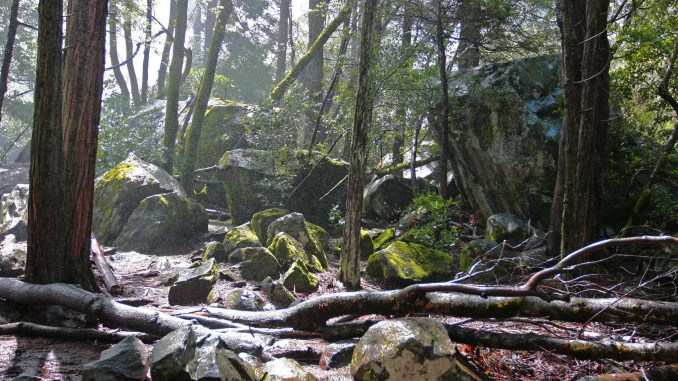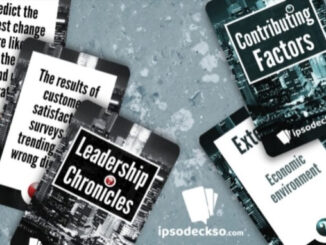
A design challenge I have frequently tackled over the past few years has been to create games which relate to the functioning of ecosystems. This is not perhaps surprising as I have been delivering learning programmes in the field of environmental sustainability.
But a by-product of this design work has been that I have also discovered that the games and mechanics I have created, also have a multitude of applications outside the topic areas they were originally created for.
It was while I was creating an ecosystem game some years ago that I started to investigate systems thinking in a serious way, and much of the research I did then led me to start work on creating a new systems practice approach to learning design. This beyond the scope of this article, but I can confidently claim that it was the design of a simple ecosystem game that led me to where I am today in my learning practice.

Seeing organisations, and even individuals as systems and parts of systems has also meant that I can find almost infinite application in these simple ecosystem games. The idea of the ‘ecosystem’ can be used as fruitful analogy in nearly any organisational learning. A few examples of how that might work in different topics/settings follow:
- Ecosystems operate at different scales and are contained within each other. A drop of water can be an ecosystem, as can the plant it rests upon, and the forest the plant grows in – and the water catchment the forest is in … and so on. Organisations can be viewed in the same way.
- Ecosystems, when their function is not degraded, are engines of productivity, where waste from one organism is the raw material used by another, and the concept of harmonious balance of function can be extrapolated from this. Also useful for learning around the ‘circular economy’.
- The need for diversity to protect structure and function, can be usefully applied to learning around team roles, ‘groupthink’, how monocultures are vulnerable to unexpected change etc.
- The idea of organisms finding their ‘fit’ niche within an ecosystem can provide powerful reflection, as can the opposite circumstance where ecosystems are disrupted or even destroyed by e.g. invasive non-native species or degradation through the unintended consequences of human action.
Below are design notes for an ecosystem games, which has been used both literally (to support learning about environmental sustainability) and analogously in organisational learning in various topics. The full game design is available in Downloads – for the purposes of the article I have included just representative samples of the game materials and instructions
Objectives
- To introduce the complexity of systems (e.g. ecosystems)
- To reflect on working in a complex system (analogising to their own role in a project team)
- To encourage reflection on:
- Personal perspectives on environmental change – what is important
- One’s place in the work ‘ecosystem’
- How an individual can create and receive value in a work ‘ecosystem’
One Hour of play
One round of activity – 15 mins
Reflection – 15 mins
Second round of activity – 15 mins
Reflection – 15 mins
Facilitator instructions
Divide group into teams of five. If there are fewer people in a team
For teams of three – Leave out roles Four and Five
For teams of four – Leave out role Four
If there are more in a team, the sixth team member can be assigned to take a ‘helicopter view’ of how the whole system works, meaning they can look at all the role cards and suggest to players how they might play for the benefit of the team as a whole. This role can be rotated to another member for the second round
Allowing teams of between 3 and 6 people will allow us to implement the game for any whole group size of three or more
How to run the game
- Distribute role briefs and round one instructions
- Give each team a stock of coloured cubes to represent the production and consumption in their ecosystem
- Briefly explain the rules, using the script below
- While teams are playing, circulate in case any teams are unsure about instructions
- After 15 mins reconvene whole group for teams to feedback on their experience, and for debriefing
- Teams should stick to 2 minutes at most. The remainder of the time should be used to draw out discussion using the debrief questions
- Distribute role briefs and round two instructions
- After 15 mins reconvene whole group for teams to feedback on their experience, and for debriefing
- Teams should stick to 2 minutes at most. The remainder of the time should be used to draw out discussion using the debrief questions
Materials
- Five (or as above for smaller teams) role cards for each team
- One copy of Round 1 instructions for each team
- One copy of Round 2 instructions for each team
- Coloured wooden cubes in five different colours
The role cards contain information about what each member of the team produces and consumes, which are represented by the wooden cubes. In each round different climate change effects occur and the cards also contain information about how that affects consumption and production.
Here is a sample role card (top part)

All the role cards can be downloaded along with the rest of the written materials from downloads
Round 1 instructions script
“I have given you all a set of role briefs and some instructions to play the first round. These are the rules of the game – which are also written on your Round Instruction sheet.
- You play for 15 mins and then we will meet as a whole group again
- You want to operate successfully as a system, but you will need to decide for yourselves what that means. At the end of the round you will get a chance to present your insights on how successful you have been.
- Read the round instructions and work out how Climate Change will affect each of the roles in your system
- All roles produce and then consume – everybody does this in order – role 1 first and then role 2 and so on
- Any units of production left over after all roles have consumed is pollution
- Resolve the pollution effects after all roles have both produced and consumed
- Take as many turns as you wish within the 15 minute time limit
I will be available while you play in case you get stuck on any of the instructions. OK you have 15 minutes.”
Round 1 Instructions
- The round last for 15 mins
- Climate Change effects are resolved before anything else happens. These will affect how much you produce and consume, so must be noted before those processes happen. In this round the Climate Change effects are:
- High temperatures
- Drought conditions
- You take your turns in order (role 1 goes first, then role 2 and so on)
- All roles produce
- All roles consume
- Any units left over are ‘pollution’. Pollution effects are resolved after everyone has taken both their ‘produce’ and ‘consume’ turns.
- You may take as many turns as you decide during the round – up to the 15 minute limit
Your Goal
Your goal is to be ‘successful’ both individually and as a whole system. What ‘successful’ means is also part of what you need to resolve while you play and talk. You may also need to come up with some form of ‘admin’ process to track what happens in your system. You may want to think about:
- how the system works as a whole
- how individual characteristics interact with the whole
- The tensions between individual and system ‘success’
Each member of the team has a special constraint or ability, which will affect how the role will play out. Also, each role has a ‘secret goal’ which must not be revealed to the other members of the team.
The bottom half of the role card contains both these items.

What to bring to debrief
Having decided what ‘successful’ looks like for your system, you must present your insights back to the whole group – in whatever way you choose – in two minutes or less.
Round 1 debrief questions (examples)
How did you go about deciding what success looked like within your system?
Do any of you feel that your individual requirements were not adequately considered when looking at ‘success’?
Does anyone want to talk about how their individual goal influenced how they played?
How did you go about tracking what went on in your system?
You all went through the same process. How would you account for the different perceptions between teams?
Was there a conscious decision making process about how many turns you took, or did you just ‘suck it and see’?
What felt particularly constraining about the rules? What freedom, if any, did you feel you had to influence outcomes?
Round 2 instructions script and debrief questions
Please see document in Downloads for these materials, as well as all the role cards
- James Bore – The Ransomeware Game - 13th February 2024
- Ipsodeckso – Risky Business - 23rd January 2024
- Review – Luma World Games - 15th December 2023





Insightful game application for raising awareness levels associated with ecosystems.
Every time I have facilitated this, I am amazed at the different insights that emerge each time. It is such a simple mechanic, and yet the reflection could be really complex. I think it is an artefact of it being a living system which inherently means that things emerge which cannot be discerned by just looking at the rules.